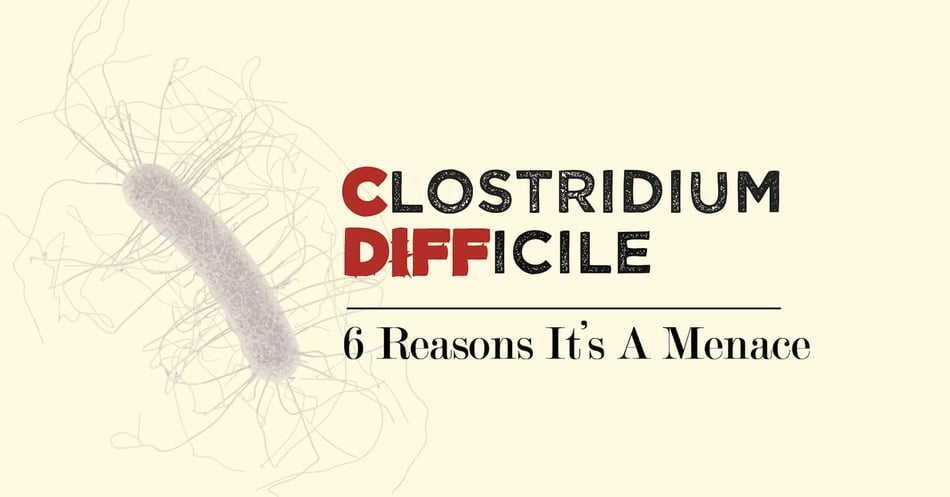6 Reasons Why C. diff is a Menace

There are 6 reasons why Clostridioides difficile is such a menace. Each one of these aspects makes C. diff infections, or CDIs, a force to be reckoned with. All six make it one of the greatest threats in hospital infection control.
1. RESISTANT
Antibiotics | Naturally resistant due to many mobile genetic elements (over 10% of its genome) that make it adapt (resist) antibiotics quickly and efficiently.
Antibodies | Creates a pseudomembrane along the inner lining of the intestines that prevents the immune system’s antibodies (and certain antibiotics) from reaching it.
Environment | It releases spore when under environmental stress which makes it survive intense heat, dryness, and chemicals (including alcohol-based cleaners).
2. VIRULENT
Toxins | Releases 2 strong toxins as it metabolizes that are highly damaging to the epithelial tissue in the intestine.
Genome | The many mobile genetic units also give the pathogen more virulence, leading to more dangerous strains, such as the hypervirulent North American strain, BI/NAP1/027.
3. PERSISTENT
Spores | Creates spores while still in the host which are then shed; these spores can withstand extreme heat, dryness, chemicals and radiation. They can survive on surfaces for up to 5 months.
Colonies | Can colonize host without symptoms that can still infect others by shedding spores. These symptom-free (asymptomatic) hosts shed spores at the same rate as symptomatic patients.
Recurrent | Can stay in host’s body and causes recurrent infections in 1:5 patients. These recurrent infections are not more virulent but, can cause added stress to a patient already struggling with a chronic condition or to an elderly patient.
Pervasive | It is found in all healthcare settings and around the world. The CDC lists it as an "urgent threat". A literature review of over 200 CDI studies from around the world identifies it as a "global burden".
4. OPPORTUNISTIC
Toxins | Releases 2 strong toxins as it metabolizes that are highly damaging to the epithelial tissue in the intestine.
Genome | The many mobile genetic units also give the pathogen more virulence, leading to more dangerous strains, such as the hypervirulent North American strain, BI/NAP1/027.
5. LETHAL
Deaths | Of the approximately half a million cases of CDI in the United States, about 30,000 resulted in death; 80% of CDI deaths are 65+.
Mortality | 6-11% mortality rate at 30 days post diagnosis; 26.3% mortality rate at 1 year post diagnosis.
6. EXPENSIVE
Costs | The average CDI adds $72,000 in medical cost to the year following diagnosis if the patient doesn't have a reoccurrence. That number can stretch to $207,700 for patients who have 3 or more reoccurrences within that first year. This adds up to $5 billion nationally for initial CDI infections plus about $2.8 billion more to treat patients with a reoccurrence.
Penalties | CMS reporting of C. difficile infections began in September 2015, which lead to better infection tracking nation-wide. However, it also result in lost reimbursements to hospitals with too many CDIs.
Check back in to the blog next week, as we conclude of series C. diff with how to break the cycle of infection and calm that perfect storm.
Editor's Note: This post was originally published in April 2016 and has been updated for freshness, accuracy and comprehensiveness.
![EOScu Logo - Dark - Outlined [07182023]-01](https://blog.eoscu.com/hubfs/Eoscu_June2024/Images/EOScu%20Logo%20-%20Dark%20-%20Outlined%20%5B07182023%5D-01.svg)

![[infographic] Stopping the C. diff Cycle Download and share!](https://no-cache.hubspot.com/cta/default/216314/interactive-178280319550.png)



